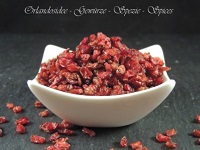
Barberry (Berberis vulgaris) — Dried Berries
Barberries are small, ruby-red dried berries from Berberis vulgaris (family Berberidaceae), found across Europe and Asia. In the kitchen they bring a clean, tart sparkle to rice dishes, salads, stuffings and pilafs.
- Common name: Barberry
- Latin name: Berberis vulgaris
- Family: Berberidaceae
- Origin/Provenance: Europe and Asia
- Synonyms: zereshk (Persian), European barberry
- Form: dried berries (seeded or seedless)
Origin & Botany
A hardy, thorny shrub, Berberis vulgaris carries clusters of small red berries. Ripe berries are picked, cleaned and gently dried, then stored cool and dry to preserve their vivid color and tangy taste.
Flavor Profile
Bright, lemony tartness with subtle fruity notes. A quick sauté in fat softens the acidity and highlights gentle sweetness.
Culinary Uses & Pairings
Classic in Persian-style barberry rice (zereshk polo). Fold through pilafs, couscous, tabbouleh, roasted vegetable salads, poultry stuffings or grain bowls. Pair with saffron, cumin, coriander, pistachio, almond, dill and parsley.
Preparation
- Rinse and soak berries 5–10 minutes in lukewarm water; drain well.
- Sauté gently in a little butter or oil (optionally with a pinch of sugar) for 30–60 s; avoid scorching.
- Fold into rice at the end of cooking for bursts of color and acidity.
Dosage & Tips
- Rice/pilaf: 1–2 Tbsp berries per 250 g (9 oz) raw rice (serves 2–3).
- Salads & stuffings: about 1 Tbsp per 250 g (9 oz) base.
- Barberries burn quickly — keep heat moderate and stir.
Ingredients & Allergens
Ingredients: Dried barberries (Berberis vulgaris).
Allergens: none mandatory in EN labeling for this single ingredient.
Storage & Shelf Life
Store airtight, cool, dry and away from light. Best enjoyed within 12–18 months. Keep moisture out to prevent clumping.
Substitutes & Ratios
Closest everyday swaps: dried cranberries (sweeter; use 1:1, then reduce any added sugar) or chopped dried sour cherries (1:1). For a purely tart accent, a pinch of ground sumac (~1/4 tsp per 1 Tbsp barberries) can help.
Related Entries
- Saffron
- Sumac
- Cumin
FAQ
How do I prepare barberries for rice?
Soak briefly, drain, then sauté gently in a little fat. Fold into rice at the end so they stay plump and bright.
Are barberries sweet or sour?
Mostly sour with a light fruit sweetness; sautéing rounds the acidity.
Can I use them without soaking?
Yes, but a short soak improves texture and removes dust; drain well to avoid splatter when sautéing.
What can I substitute if I can’t find barberries?
Try dried cranberries (sweeter) or chopped dried sour cherries; adjust sweetness and acidity to taste.
Merchant contact: Orlandosidee — Spice Shop (see site imprint for full company details).



